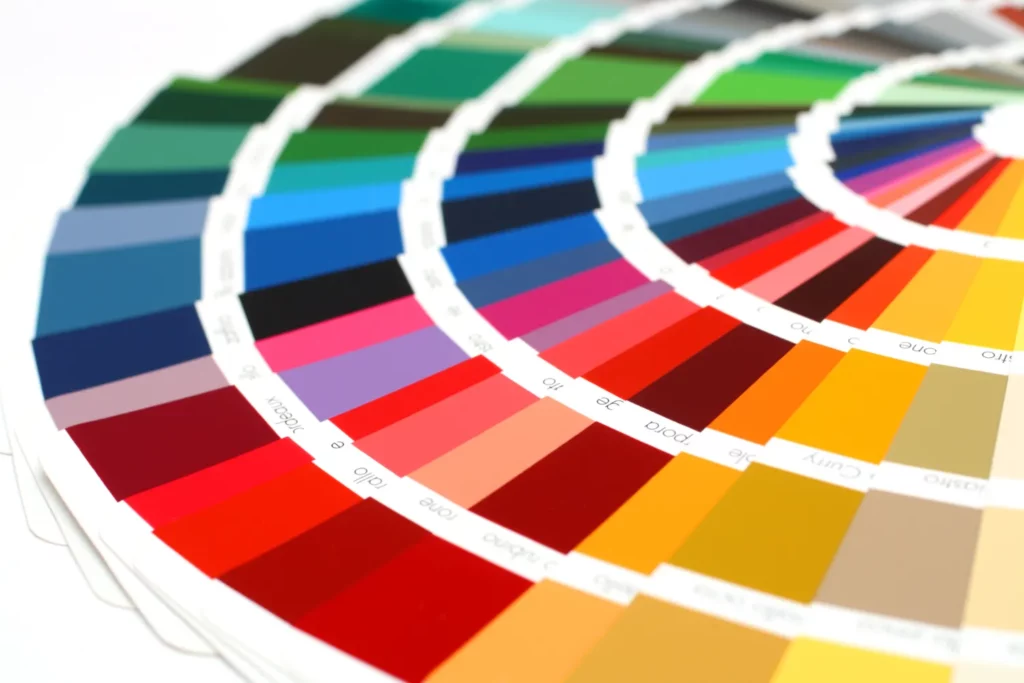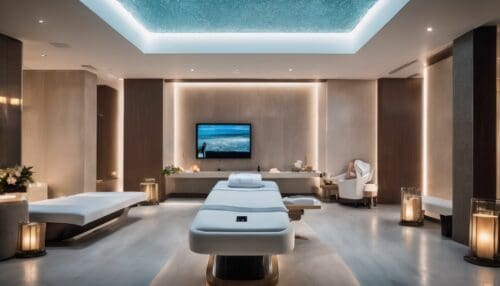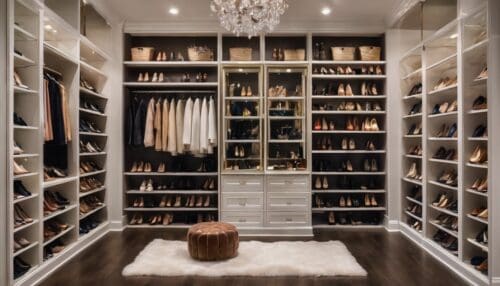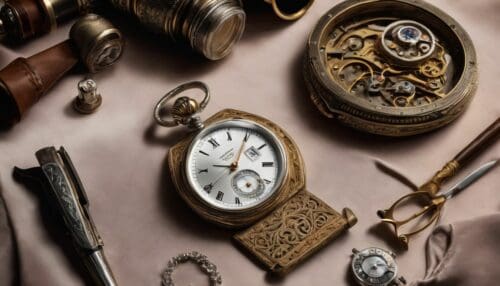Updated On: April 07, 2024 by dina
Colours play a meaningful role in our lives, influencing our emotions, perceptions, and purchasing decisions. Choosing colours becomes even more critical in luxury, where aesthetics and exclusivity are paramount. Luxury brands carefully select colours to evoke specific feelings, communicate their brand identity, and create a sense of luxury. Let’s explore the fascinating world of colours in luxury, where hues are meticulously chosen to captivate and entice.
What Do Colours Mean in The Luxury World?
Luxury brands understand the power of colours and their ability to evoke emotions and create a distinctive visual identity. Regarding luxury, specific colours have become synonymous with opulence and exclusivity. Here are some unique colours frequently used in the luxury world:
- Classic Black: Black exudes elegance, sophistication, and timelessness. It signifies power and formality and is often associated with luxury brands focusing on understated luxury. Black is a popular choice for high-end fashion, accessories, and luxury vehicles, adding a touch of mystery and allure.
- Rich Gold: Gold has long been associated with wealth, luxury, and prestige. Its radiant hue symbolises prosperity and is often used in luxury branding and packaging to convey a sense of opulence and extravagance. Gold accents are commonly found in high-end jewellery, watches, and interior designs.
- Regal Purple: Purple is a colour that exudes royalty and luxury. Historically, purple was reserved for the elite, as obtaining the dye was complex and expensive. However, luxury brands utilise purple to evoke a sense of grandeur, indulgence, and exclusivity. It can be seen in high-end cosmetics, perfumes, and upscale fashion.
- Elegant White: White represents purity, minimalism, and sophistication. Luxury brands employ white to convey a sense of understated luxury and impeccable taste. It is often used in high-end fashion, home decor, and luxury hotel designs to create an ambience of elegance and tranquillity.
- Timeless Red: Red is a colour that embodies passion, power, and desire. Luxury brands leverage red to create a sense of allure, indulgence, and excitement. It is frequently utilised in high-end cosmetics, perfumes, and luxury sports cars, capturing attention and igniting a sense of luxury and exclusivity.

What Colours Represent Luxury?
In the world of luxury, several colours are commonly associated with opulence, prestige, and exclusivity. Here are some colours that often represent luxury:
- Black: Black is synonymous with elegance, sophistication, and timelessness. It exudes a sense of power and is often used by luxury brands focusing on understated luxury. Black is associated with prestige and is commonly found in high-end fashion, accessories, and luxury vehicles.
- Gold: Gold has long symbolised wealth and prosperity. Its radiant hue represents luxury and extravagance. Luxury brands frequently use gold accents in their branding, packaging, and products to convey a sense of luxury and exclusivity. In addition, gold is often associated with high-end jewellery, watches, and interior designs.
- Purple: Purple has historically been associated with royalty and luxury. It represents grandeur, indulgence, and exclusivity. Luxury brands utilise shades of purple to create a regal and prestigious aura. Purple can be found in high-end cosmetics, perfumes, upscale fashion, and interior design for luxurious spaces.
- White: White represents purity, simplicity, and sophistication. It conveys a sense of understated luxury and impeccable taste. Luxury brands often use white in their branding and product designs to create an ambience of elegance and tranquillity. White is commonly seen in high-end fashion, home decor, and luxury hotels.
- Silver: Silver is associated with modernity, sleekness, and futuristic appeal. It represents a contemporary and cutting-edge approach to luxury. Luxury brands often use silver in their designs to convey a sense of innovation and technological advancement. Silver is prevalent in luxury electronics, the automotive industry, and high-end accessories.
- Red: Red is a colour that ignites passion, desire, and energy. It exudes a sense of excitement and indulgence. Luxury brands leverage red to create a captivating atmosphere. Red is commonly used in high-end cosmetics, perfumes, luxury sports cars, and upscale dining experiences.
- Green: Green often represents wealth and prosperity. It symbolises abundance, growth, and financial success. In the context of luxury, shades of green can represent opulence and affluence. Therefore, green is sometimes used in luxury branding, particularly in finance, real estate, and high-end travel industries.
- Blue: Blue is a colour that can evoke a sense of calmness, trust, and stability. In specific contexts, it can also be associated with wealth and success. Darker shades of blue, such as navy or royal blue, can convey a sense of sophistication and a luxurious feel. Blue is often used in luxury fashion, high-end home decor, and premier financial services.
- Silver: Silver is commonly associated with modernity and sleekness but also with wealth and luxury. Silver represents a sense of exclusivity, sophistication, and refinement. Luxury brands frequently use silver accents or metallic finishes to create elegance and luxury in their products, particularly in jewellery, watches, and the automotive industry.
- Brown: While brown may not be an obvious choice for luxury, certain shades of brown, such as rich chocolate or deep mahogany, can convey a sense of luxury and wealth. Brown is associated with natural elements, craftsmanship, and heritage. It is often used in luxury furniture, high-end leather goods, and upscale interior designs.
While these colours are often associated with luxury, the perception of luxury can vary across different cultures and industries. Furthermore, luxury brands may also use unique colour combinations and variations to create distinctive visual identities. As a result, colours can be subjective and vary across cultures and industries. Additionally, colour associations can also be influenced by personal experiences and cultural backgrounds. Therefore, while these colours may generally represent wealth, the specific context and execution play a crucial role in determining their effectiveness in conveying a luxurious and affluent image.
What are the Colours Used to Market Luxury Products?
When marketing luxury products, specific colours are commonly used to evoke a sense of luxury, exclusivity, and allure. While the particular colour choices may vary depending on the brand and target audience, here are some colours frequently employed in marketing luxury products:

- Black: Black is a timeless colour associated with sophistication and elegance. It is often used in luxury branding to convey a sense of luxury and exclusivity. Black creates a feeling of mystery and intrigue; it is a popular choice for high-end fashion, luxury accessories, and high-value products.
- Gold: Gold is a colour that represents wealth, luxury, and prestige. It is frequently used in luxury marketing to signify luxury and extravagance. Gold creates a touch of glamour and luxury in products and is commonly employed in high-end jewellery, watches, cosmetics, and premium packaging.
- Silver: Silver is associated with modernity, innovation, and sleekness. It is often used in luxury marketing to convey a sense of sophistication and cutting-edge design. Silver accents or metallic finishes can elevate the perceived value of a product, especially in industries like technology, automotive, and home decor.
- White: White symbolises purity, simplicity, and luxury. It is frequently used in luxury branding to create an image of elegance and refinement. White is famous for luxury fashion, high-end cosmetics, premium home appliances, and luxury hospitality.
- Red: Red is a colour that stimulates excitement, passion, and desire. It can be employed in luxury marketing to create a sense of urgency and allure. Red is often used in high-end fashion, luxury perfumes, upscale dining experiences, and luxury cars to capture attention and evoke a feeling of luxury and exclusivity.
- Purple: Purple often represents royalty, luxury, and extravagance. It is often used in luxury marketing to create a sense of grandeur and opulence. Purple can be seen in high-end cosmetics, perfumes, fashion, and interior design for luxury spaces.
While these colours are commonly used in luxury marketing, it’s essential to consider the specific brand image, target audience, and product category when selecting colours for marketing campaigns. The effective use of colours can create a strong emotional connection, enhance perceived value, and convey the desired luxurious brand identity.
What is the most expensive colour?
The “most expensive colour” concept is subjective and can vary depending on availability, rarity, demand, and cultural significance. The cost of a colour can also depend on the specific medium it is used in (e.g., pigments, dyes, paints, gemstones). Here are a few colours that have been associated with high value and rarity:
- YInMn Blue: Developed in 2009, YInMn Blue is a synthetic pigment known for its vibrant and intense blue hue. Oregon State University’s chemists discovered it and have gained attention for its unique shade. While the cost of the pigment may vary, it is considered valuable due to its rarity and the complex process required to create it.
- Lapis Lazuli: Lapis Lazuli is a deep blue gemstone prized throughout history. It was used to create painting pigments and was even more expensive than gold. Lapis Lazuli is still sought after today for its rich blue colour and is often used in high-end jewellery and artistic creations.
- Pink Diamonds: While not strictly a colour, pink diamonds are scarce and valuable. Natural pink diamonds are formed due to unique geological conditions and are highly coveted for their stunning pink hues. As a result, pink diamonds often command high prices in the market, making them one of the most expensive gemstone colours.
- Tyrian Purple: Tyrian Purple, also known as Imperial Purple, is a rich, deep purple dye that was historically derived from the secretions of certain molluscs. It was highly prized and was associated with royalty and luxury. The labour-intensive and costly process of producing Tyrian Purple made it one of the most expensive colours of its time.
Various factors, including cultural trends, historical significance, and market demand, can influence the value and cost of colours. The perception of a colour’s value can also vary across industries and contexts.
What is a legendary colour?
In the context of colours, a “legendary colour” typically refers to a colour with significant historical, cultural, or symbolic importance. Legendary colours are often associated with powerful narratives, myths, or iconic figures. Here are a few examples of colours that have gained legendary status:

- Royal Purple: Purple, specifically a deep and rich shade known as “royal purple,” holds a legendary status due to its historical association with royalty and nobility. In ancient times, the dye used to produce purple fabric was scarce and expensive, symbolising power and luxury. As a result, this colour has been associated with renowned figures such as Roman emperors and kings throughout history.
- Imperial Yellow: Imperial yellow, a vibrant shade of yellow, holds legendary status in Chinese culture; this is because emperors exclusively used it during ancient China’s dynasties, representing their supreme authority and divine connection. As a result, imperial yellow became a symbol of imperial power and was reserved for royal use only.
- True Blue: “True Blue” is a term used to describe a deep and pure shade of blue. It has gained legendary status due to its association with loyalty, steadfastness, and trustworthiness. As a result, true blue is often used in cultural and literary references, emphasising its symbolic importance and enduring qualities.
- Legendary Gold: Gold, the colour of precious metal, holds legendary status across many cultures and civilisations. It has long been associated with wealth, prosperity, and divine power. In addition, gold’s inherent value and shimmering appearance have made it an enduring symbol of luxury, success, and achievement.
- Mythical Green: Green is sometimes called a “mythical” colour due to its association with nature, fertility, and rebirth. Green is linked to mythical creatures, enchanted forests, and otherworldly realms in various mythologies and folklore. It has a sense of mysticism and wonder, lending it a legendary allure.
These legendary colours have transcended their physical attributes and acquired deeper meanings and significance through historical, cultural, or symbolic contexts. As a result, they continue to evoke powerful emotions and associations that have stood the test of time.
What’s the unique colour?
Defining the “most unique colour” is subjective and challenging since individuals can interpret uniqueness differently. However, one colour often considered unique is Pantone 448 C, also known as “Opaque Couché.” This colour gained attention when described as the “world’s ugliest colour” due to its dark, muddy appearance. Opaque Couché was specifically selected for its ability to discourage smoking and was used in tobacco packaging regulations in some countries.
While Opaque Couché may be considered unique for its specific purpose and reputation, uniqueness in colour can also be found in individual perceptions and personal preferences. For example, rarely-seen colours, unconventional colour combinations, or hues with distinctive characteristics can all be considered unique. Additionally, the uniqueness of colour can depend on the context in which it is used.
Ultimately, uniqueness in colour is subjective and open to interpretation, making it a fascinating aspect of human perception and creativity.
Colours hold immense power in the luxury world, enabling brands to establish a visual identity, evoke emotions, and convey a sense of luxury. Furthermore, each colour is crucial in communicating luxury and exclusivity, from black’s timeless elegance to purple’s regal allure. Therefore, understanding the psychology behind colours and their impact on consumer perception is vital for luxury brands to create captivating and memorable experiences. In the world of luxury, colours go beyond aesthetics—they become a language of luxury that speaks to the desires and aspirations of discerning consumers.











